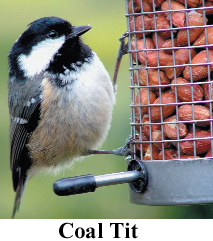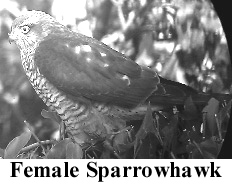|
|
  |
|
|
  |
Wildlife
Newsletter for the Township of Dalkey December 2008 - Michael Ryan |
 |
If you feed the birds in your garden you might have noticed there’s an awful lot of hungry Coal Tits around. Apart from a number of peanut feeders we have three sunflower seed feeders, one a double one with four bays for the birds to feed from and these are the most popular with these birds. For all of the autumn we’ve had to refill them at least three times a day and the garden is like a pin ball machine with coal tits rapidly flying in and back out again as if they’re bouncing off the feeders. Coal tits don’t eat at the feeders but take the seed away to eat it or store it for later. I buy sunflower seeds by the sackful - of 20 or 25 kilos weight - and the sacks only last afew weeks. Then I heard that it wasn’t just me who was been driven into a recession by hungry birds. A friend who logs on to bird-related chat sites told me that lots of other people, in Britain as well as in Ireland, were reporting unusually large numbers of coal tits in their gardens. In winter a lot of the birds we’d see during the summer are supplemented by birds of the same species arriving from northern and Eastern Europe to our milder winter climate. |
| We usually
associate migrants with birds like swallows in the summer and geese in the
winter but even robins and tiny goldcrests can move south in big numbers when
the ground gets frosty and food is scarce. The
Scilly Isles, because of their position in the channel are famous for attracting
large numbers of migrant birds and some years they have trees which are almost
covered with migrating robins. Incidentally they can tell which robins are
the normal residents on the island because they show no fear of people while
the visitors will scatter. So are the masses of coal tits in our garden visiting northern European residents? Apparently not, they’re probably Irish birds. And how do we know? Because coal tits are one of a small number of bird species which have a distinct Irish race. A race is like different breeds of dogs, they’re all the same species but races like breeds display distinct features. As well as the coal tit we have Irish races of Jays and Dipper and Red Grouse all having a slightly different appearance which takes a degree of studying to recognise. Our coal tits are the same species as the British and European birds and could theoretically breed with them but our race has distinct unique characteristics. Where European coal tits have white patches on their cheeks, breast and belly in our race this area has sulphur yellow tones and our race has the appearance of a paler rump. The Irish race has a slightly bigger beak as well but you’d have to be very confident of your observation skills to call on that one. We still don’t know why there are so many of them this year and the question seems to be: did they have a very good breeding season or is there a shortage of natural food which is driving them into gardens? Let’s hope it’s the former and the birds are just taking advantage of the food we leave out for them. |
| I
met someone recently who said although she was spending loads on bird food
she didn’t regret it for a minute for all the satisfaction she got from
watching them and knowing that she was helping them survive and that would
seem to be a universal feeling of everybody who feeds birds. A couple of feeders
and a few bags of peanuts or sunflower seeds could be a very nice Christmas
present for someone you know who likes nature and wildlife. We were delighted
recently to see a pair of Jays in the garden perched in the apple tree that
my feeders hang from. A friend in Killiney had three of them spend the winter
in his garden eating peanuts and he said they became very territorial of his
car, screeching whenever anyone went near it Last month’s newsletter had a photograph of a grey squirrel which first appeared |
 |
| at my bird feeders in July and has been a far too frequent visitor since. I already had hanging a peanut feeder which is marketed as being large bird and squirrel proof. The feeder is protected by a row of vertical bars through which smaller birds can get through but it prevents bigger birds and squirrels getting at the food. That’s the theory anyway. Unfortunately my visiting squirrel, although very intelligent, didn’t know it wasn’t supposed to be able to get into the feeder. I looked out one day and there he was sitting comfortably inside the feeder nonchalantly chewing away at the peanuts. He didn’t even have to cling on to the feeder or hang upside down to get at the nuts. I thought Squirrel Back Support Feeder would probably be a better description for the feeder rather then Squirrel Proof. I sneaked down to the feeders and was able to get a few feet away from the squirrel before he saw me. In a panic he tried to get out but maybe because he’d eaten so many peanuts he was a bit wider and he had great difficulty squeezing through the bars. The feeder was spinning around like a merry-go-round before the agitated creature squeezed through and bounded up the tree. There are now modified squirrel proof feeders available on which the bars run horizontally as well as vertically so they should work at keeping them out as long as there aren’t grey squirrels out there developing squirrel paw sized wire cutters! |